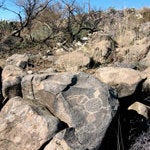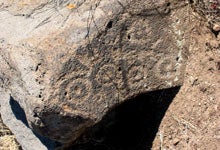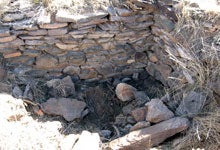Legacies on the landscape: prehistoric human land use and long-term ecological change (Funding: NSF-DEB: 0614349)
How long do human activities last on the landscape? Does land use intensity affect the ecological legacy of human settlements? In this new project developed jointly with ASU archaeologists, we will explore how prehistoric agricultural communities affect the nature of ecological processes for thousands of years through plant communities, soil properties, and biogeochemical cycling.
Project Summary:
Ecologists have begun to realize that many previously-considered “pristine” ecosystems have been altered by past land use activities. While large-scale, post-colonial land use changes are expected to some extent to leave an ecological imprint, more surprising has been the discovery that prehistoric human communities, even ones that disappeared from the landscape centuries ago, can have significant impacts on the structure and functioning of modern ecosystems. While the literature shows that the legacies of disturbance likely differ depending on vegetation type, population dynamics, and speed of nutrient cycling through ecosystems, only a handful of studies have explored long-term ecological legacies of human disturbance through the archaeological record, with few of these focused on slow-growing arid land systems that take centuries or more to develop (Briggs et al. in review). Furthermore, it is likely that different prehistoric land use activities or duration of those activities have left more or less persistent imprints on the landscape, but few studies are able to test the importance of prehistoric land use intensity without the confounding effects of recent land use events. This proposal builds upon an ongoing collaboration between ecologists and archaeologists at Arizona State University (ASU) focused upon the cultural and ecological effects of recursive human-environment interactions. In this work, we propose to examine the long-term ecological legacies of land use intensity in two different ecosystem types of the southwestern US which supported agroecologically active and well studied populations of humans until 1200-1400 AD. This unique perspective, accessible only through the archaeological record, will provide us with an understanding of the importance of humans and their varied land use activities as drivers of persistent ecological patterns and processes.
We will focus our investigations across a gradient of known prehistoric human activity in arid and semi-arid ecosystems of central Arizona that represent two ends of a spectrum of human occupation in population and duration. Our first site will be located at Cave Creek, located in the Sonoran desert of the northern Phoenix basin, which supported relatively large human populations for approximately four centuries using both irrigated and dry land farming techniques. Our second site is at Perry Mesa, located at higher elevation in the semi-arid desert grasslands of Agua Fria National Monument. Populations at Perry Mesa were smaller and more ephemeral than at Cave Creek, and were supported by only dry land agricultural fields and house gardens. In each system, we will evaluate the importance of land use intensity on modern ecological properties and processes by comparing areas of high intensity use (irrigated fields at Cave Creek, rain-fed terraces at Perry Mesa) with areas of relative low use (rain-fed terraces at Cave Creek, house gardens at Perry Mesa) and nearby areas where there is no archaeological evidence of human land use (off-site controls).
The intellectual merit of this research includes a unique, interdisciplinary experimental design in the spatially extensive and understudied arid and semi-arid ecosystems of the US Southwest where prehistoric human populations were some of the largest in North America. In addition, our proposal will contribute to an emerging literature that promotes an interdisciplinary approach to ecology and archaeology and will provide a framework to aid land managers in setting goals for maintaining and restoring archaeologically rich lands in the Southwest. The broader impacts of this research include interaction and knowledge exchange between students (both undergraduate and graduate students), faculty, members of local Native American communities for whom these lands are ancestral, and land managers at the Agua Fria National Monument and Tonto National Forest.



